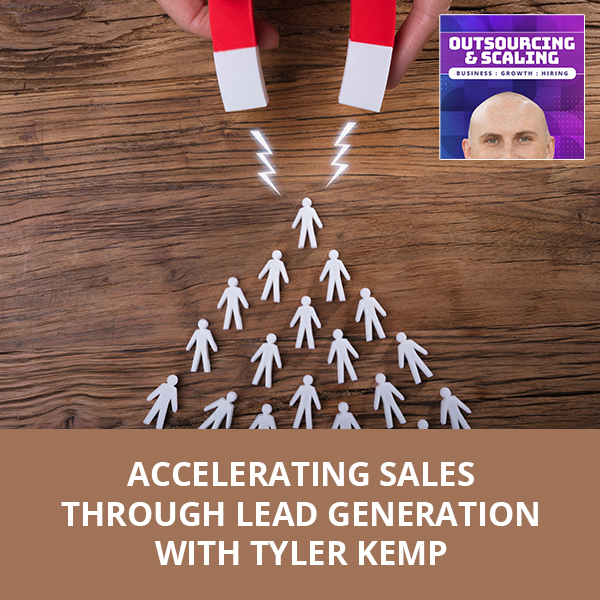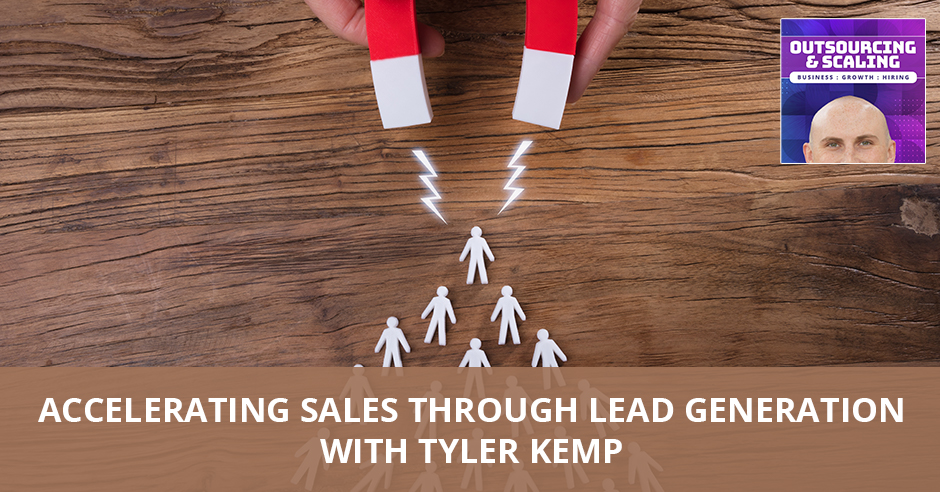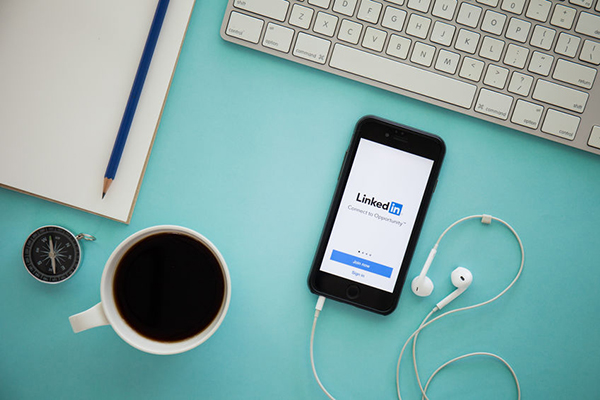


Lead generation is lifeblood to almost all businesses globally. That is why learning the best way to do it has become a necessity for most entrepreneurs. Thanks to amazing minds like Tyler Kemp, the CEO and Founder of LeadRoll.co, generating leads has become one step easier. With his knowledge, he shares his secrets on how he has been marketing for top producing salespeople as well as how he incorporates his hiring tactics and lets freelancers do some lead generation tasks for him to save time. Although platforms like LinkedIn has made luring the right people to your product become more convenient, determining the right platform to use is crucial.
—
Listen to the podcast here:
[smart_track_player url=”https://www.podetize.com/statsapi/www.podetize.com/wp-content/uploads/fileuploads/11-5b145ef137b51b3d1af0633e9305c43d/10/2019/794ff69e130a2eef1b29fe06dda43780.mp3″ title=”Accelerating Sales Through Lead Generation with Tyler Kemp” ]
Download the audio file here.
Accelerating Sales Through Lead Generation with Tyler Kemp
This episode is all about lead generation and I have Tyler Kemp. Tyler. How are you doing?
How’s it going Nathan? Good to see you.
Good to have you on. Tyler has been marketing for top producing salespeople, has gone from participating in the marketing advisory board of a $16 billion with a B company to helping software startups scale national sales force. He operates a sales accelerator service exclusively for B2B sales helping them generate predictable leads on LinkedIn for as little as $99 a month. Tyler, I’m excited to talk to you all about LinkedIn lead generation, but first let’s take a gigantic step back. What were you like growing up? Were you a rebel or were you a straight-A student? Did you always know that you wanted to be an entrepreneur?
I was a big-time nerd, totally still am. I’m not sure if that’s a good thing or a bad thing but that’s how it is. How’d I do at school? I was a theater nerd. There’s a big difference, music things like that and when it came to school, I was the type who did the things I wanted to do and almost nothing else at least not until college in which case at that point you go for it, so that was great.
Walk us through the journey a little bit. How did you find out that you wanted to be an entrepreneur? What was your first entrepreneurial endeavor?
I started my first company back when I was about 22 with my father. He was running a marketing company. He was a career marketer for 25, 30 years and he was getting tired of it and I was like, “Why don’t you come do this thing with me and we’ll go all in?” He said, “Sure.” He dropped what he was doing. He was in WordPress developments at that time and we ran this little company for three years. By the end of that, I realized I was good at one particular thing and that is generating deals, bringing in new business and I wasn’t great at the rest of the stuff. I didn’t like it as much. I’d be much more of fall into a category of the salesperson than I would the operations manager. That was my background and things went from there.
Generating leads mean getting strangers into your sphere and getting their attention.
How do you divide up sales versus lead generation and where does that merge? Because I feel there are some people who are great at lead generation but can’t close a deal. There’re other people that can close the deal, but they need the lead brought to them. There’re other people that can do both. How would you break that down?
In the end, sales and marketing are definitely two sides of the same coin because you might find yourself doing either at any one moment. I’m selling in one moment, then I’m doing marketing in another. At the same time when it comes to being a finder, lead generation is the finding. When you are generating leads, you’re bringing people who don’t already know you, who might not ever have known you into your sphere and into your ecosystem and getting their attention. Sales takes over when, “I’ve got their attention now, I’ve got to close that deal. I’ve got to get this person to know. Trust me and if it’s a good fit, work with me.” Lead generation definitely takes care of that first effort of I’m going to go and get people’s attention when they don’t know me right now.
How did you become good at sales? Because everyone gets there a different way. For example, I got thrown in the fire. I was a sales intern. They said sell these credit cards, car services and I knew nothing about cars and I did it until I figure it out. Other people read books and they study or follow a mentor. How did you become good at it?
Trial by error and trial by fire. I ended up joining forces with some people in the mortgage space and this was after I’d run my first company. I’d met a gentleman, he and I used to network a bunch and he mentioned that he needed some marketing support. I was about to make a career transition into full force marketing and he had been doing $100 million in loan volume every single year. This guy was a complete beast. He and I had this arrangement based on some of my past success at the time where I was like, “What are your goals? Where do you want to be in five years?” He was like, “In five years I want to be at $120 million in loan volume.” He showed me his books, I checked things out and we made this arrangement where I was like, “What if we got you to that point in one year, can we do that?” At that point, he was like, “If you can get me to $120 million in a year, we got a deal.” I joined his organization and we got to $120 million that year in twelve months. I learned from him how to be a good closer and when you’re working with career lenders, it’s a competitive field. You have to get good or you’re gone.
You get to the point where you’re a good closer. A lot of people reading, they know how to close, but they’re wondering how do I use virtual assistants? How do I use freelancers to help me get leads to generate leads and to that I can use my closing skills? How does the virtual assistants, remote freelancer come into play here?
Anyone trying to do any marketing, it comes down to, “What do you need to do yourself and what can you leverage your team for?” There’s only so much, especially if you are in sales or if you are a sales CEO that you can handle to do. If you are at all successful, one of the first things you should do is reinvest into a team because there are so many things that need to be done that are beyond our bandwidth to take care of. For example, social media marketing is a simple generic thing. It’s not complicated to be active on social media but which of us has time to sit down and write new content, come up with stuff every single day if we’re dialing for dollars? If we are booked enough to have business coming in the door, that stuff becomes hard to do on a consistent basis.
How do you use freelancers to generate new deals? Identify what role do you want them to fill because as you know, at least in my experience, there’s a lot of direction necessary so you almost have to have your strategy, your tactics and your methods worked out beforehand. When it’s time to bring in more support I found a lot of success and plugging people into my system where it’s like, “Here’s how we do things X, Y, Z. Can you do this a thousand times?” Or find someone who’s good at that one thing better than I am, that I need to get done and work with them to get it done.

I always say there are three different levels of people you can hire. You can hire the followers, virtual assistants, non-US VA’s. You can hire the mid-level specialists, the graphic designers, maybe they’re good at a social media channel or they’re good at writing. Then you’ve got the experts, the PPC experts Amazon or whatever it is. Are you saying for lead generation you’re tailoring more towards those followers, the non-US virtual assistants?
It depends on where you’re at in your business. If I were a salesperson and I’m making any money at all, the first thing I would do is work with people who are doing it because there are so many ways you can do it wrong, so much learning involved in generating leads. Most business owners have tried to generate leads. That’s the lifeblood of our business. If you’re struggling with it and you haven’t been able to do it successfully, then it’s going to be hard for you to tell someone else who’s a follower what to do. If you are brilliant marketing mind and you’ve got plenty of leads, but you can’t manage it, that’s when you can bring on followers to do it. If you need someone to take you from zero to leads, then you probably need to be on the higher end of the of the agency spectrum.
Let’s say the A service provider, they’re reading this podcast. You’re saying, “I want leads, where do I go to get my leads?” There’re so many different channels from Facebook to LinkedIn, which I know you specialize in, to go in at conferences. How do people figure out where they should be spending their time and where their leads are located?
I would start with what kind of leads are they. Are they consumer leads? Because if you are selling some protein shake, eCommerce, LinkedIn might not be a place to go. You might want to start on Instagram. You might want to start on Facebook and do some paid advertising, do partnerships, things like that. If you are a B2B sales professional, LinkedIn becomes an absolute no-brainer. If you sell to other businesses or even if you can get referrals from another business, that is something we’ve had a lot of success in, is use LinkedIn to network. A lot of people think of it like a resume. It’s a virtual resume, but it is a business network. You go to a networking group with people you don’t know and accept at hundreds and hundreds of thousands of these people and you know everything about them by looking at their profile or by using LinkedIn’s advanced search filters.
We started off and we don’t even begin in LinkedIn. We began broader. Facebook Ads were definitely the propeller for my career for a very long time because if you and I were talking years ago, we would be talking about Facebook Ads. That would be the thing that is the big buzz, but what we’re finding is that LinkedIn is starting to generate that buzz because I can generate a lead without a landing page, without any paid ads or complicated funnels without any variable cost of any kind. For our customers, we do lead generation at a fixed cost so there’s no question how much it’s going to cost them. There’s no hourly anything. It’s all flat rate and that’s hard to do in any other platform.
When I think of LinkedIn, I think of all the spammy messages I get. If I open up my Messenger, I have a ton of messages from service providers and some people are sick of getting them. How do you stand out? How do you deliver a good message? How do you get in front of your lead without turning into all the other spammy messages that people get?
One thing that separates you and your message from the pack is relevancy.
Everyone gets a little tired of those to be honest. In the end there’s one thing that is going to separate you and your message from the pack and that is relevancy. You need to be relevant to somebody. The other thing is to be different. I’ve always had a philosophy which is, “To be different is better than to be better.” If you serve an ad, you ask the same question, “How do I get my ad seen instead of all the other ads all over the place? How do I get them to click that link instead of all the other things?” I believe that human connection is what’s going to continue to win in the end.
Can you give us an example of how we will stand out with one of your clients?
One of my clients is using LinkedIn to recruit new directors. This is a VP who wants to hire new directors and bring them on to their program. In order to cut through the noise, you have to do a couple things. One, you need to nail your targeting. The way you nail your targeting on LinkedIn is to use LinkedIn Sales Navigator. That is their mid-level premium program. You pay LinkedIn about $80 a month or so and it does two main things. It gives you access to advanced filters and it uncaps your account. If you are on the free version of LinkedIn, it’s going to be hard to use it as a legion tool because you can only reach out to so many people every day that you don’t know.
If you have LinkedIn Sales Navigator, LinkedIn wants you to reach out to people that you don’t know. That is the whole name of the game, its sales. You can filter down based on targeting and dial in and say, “I want to see people in this particular industry with this particular title.” You can even say, “I want to know people at this company.” Maybe there’s a broad company and you want to do account-based marketing to that company. Let’s even say it was mortgage and I want to target all the loan officers across the country. Let’s say Guild Mortgage Company. Then LinkedIn can give you not just a number of all of these people, but it’ll show you their actual profiles to select faces with names. Getting that specific, that targeted is your first step. The next step is to get yourself in front of them and get into their network.
There’s a variety of things you can do to be successful with connection requests that are cold, but it begins with tailoring. Make sure that you know something about them whether that be where they live or the company they work for. If you are copying and pasting a message that doesn’t contain any variable component, it’s going to be less effective. It’s not that it won’t work but it will be less effective. Before the connection, your job is going to be, “How do I get myself in front of that person and get them to connect?” One of the factors here is your profile. If your profile isn’t tuned for sales but without being too salesy, meaning you don’t want your profile to be a bunch of noise, you do want your profile to be relevant and specific. My best advice to someone tuning up their profile is don’t make it about you, make it about your prospect. If you’re in sales, use your description, your title. You have to resonate a singular message with your prospect, their pain and problem not yours.
That is going to help you when you’re reaching out to somebody you don’t know to get them to connect with you. The next stage is, “How do you build that relationship because you can connect with somebody then they never hear from you again, and you’re not doing do any business with that person?” Cutting through the noise in your follow-up messages at that point is going to be the first step that you would do. How do you cut through the noise? Same principles apply, be relevant, be human and intimate and make sure that you’re not pushing a sales message in your first message. Unless you’re dealing with a certain company that if you don’t want to waste your time and you’re like some people, it works best to introduce, “I do this.” Any interest at all and that can work but I would focus on relationship first, especially in any high-ticket sales.

What are some of the common mistakes you see that people make on LinkedIn? I’m sure you deal with this all the time you’re viewing lots of people’s profiles and working with different clients across different industries. What are those mistakes?
You brought up one of the first and most important mistakes which is being too salesy too quickly. If someone feels like they’re being sold or that they’re about to be sold, that doesn’t work. It’s not going to continue to work as much as being authentic and being human. If someone looks at you and they say, “I can resonate somehow with this person,” that’s going to be better than, “Buy now,” and all of these buying signals that you’re trying to push down their throat. That’s the first one, don’t be too salesy. The second thing is treating LinkedIn like a networking tool and not a resume like we spoke about. Don’t use LinkedIn with people that you already know. A lot of us, even a few years back have had this mindset like, “I’m only going to connect with people that I know.” If you do that, you’re going to miss out on a huge opportunity to meet people that you don’t know that are right there to be had. LinkedIn has amazing organic reach better than any other platform that I’ve seen and to miss out on that would mean missing out on sales.
The final mistake that I would think of is, make sure that you’re investing in content generation. If you connect with somebody, and LinkedIn is a place where you have all of this organic reach, all of its potential, but you say nothing and you’re invisible, then you’re not going to be building influence. We live in an economy where influencers are on the rise. That is the kind of marketing that is working. You Nathan, are an influencer. I want and try to always be an influencer and that if we are building up these personal brands on LinkedIn, even if you work at a massive corporation, people are going to buy from you. Serve content to make sure that people consume value before trying to make that sale.
Tyler, this has been great. I learned a lot about LinkedIn. Where can people find out more about you and what are you most excited about?
People can find us or me at VentureTactics.com. We’re going to be going through a rebrand here pretty quickly. We are at that stage of growth where we’re dialing in, doubling down and expanding our brand. We’re going to be changing some things. We’re on the verge of figuring out some things on how to get massive amount of people into our ecosystem and massive amount of people into the ecosystems of our clients. I’m so excited to see how big and how far can this go. How far can lead generation on LinkedIn go? I can’t promise that it’s going to be effective for years. How many things change in social media? I don’t know. What I do know is, this is working better than our Facebook, Instagram or YouTube ads combined. This strategy for B2B sales is crushing it. I’m excited about seeing where this goes, where it leads, how many people we can serve, help get more business, get more deals and how low can we keep the cost. We can generate leads for as low as $99 a month flat rate up to $1,000 a month flat rate. We keep it pretty streamlined to go for a volume and that’s we hope to be able to keep it.
Thanks, Tyler.
Thank you, Nathan.
Important Links:
About Tyler Kemp
 Tyler Kemp has been marketing for top producing salespeople for nearly a decade and has gone from participating in the marketing advisory board of a $16 Billion company to helping software startups scale a national salesforce. He now operates a sales accelerator service exclusively for B2B salespeople helping them generate predictable leads on LinkedIn for as little as $99/m flat.
Tyler Kemp has been marketing for top producing salespeople for nearly a decade and has gone from participating in the marketing advisory board of a $16 Billion company to helping software startups scale a national salesforce. He now operates a sales accelerator service exclusively for B2B salespeople helping them generate predictable leads on LinkedIn for as little as $99/m flat.
